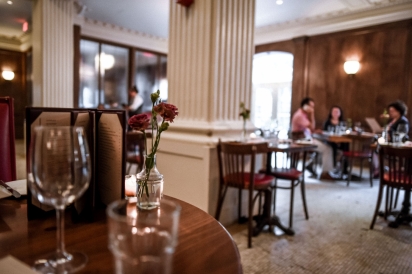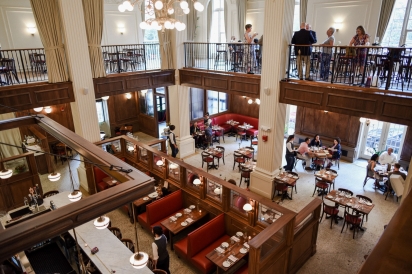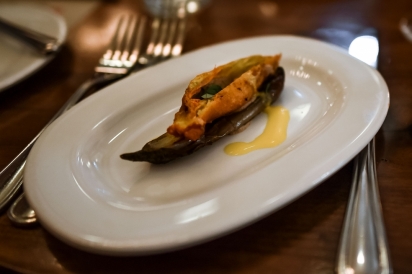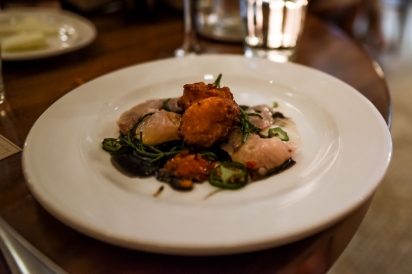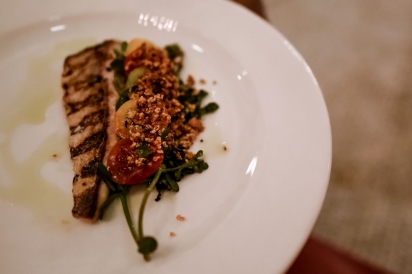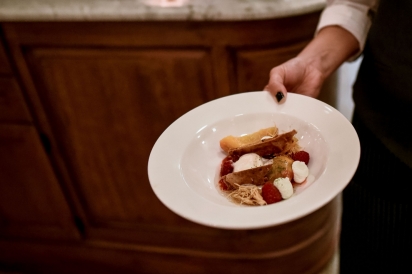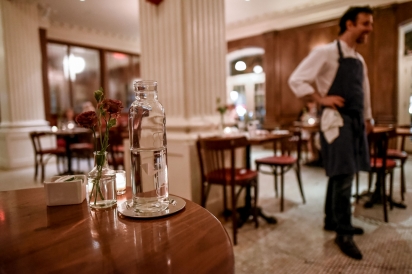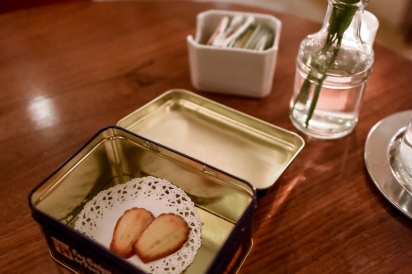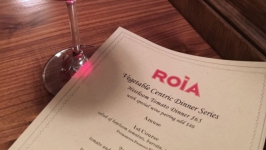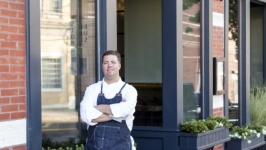A Collaborative Dinner Blends Old World Opulence and New Age Innovation
Stepping off New Haven’s College Street into the tall, open space of French-Italian restaurant ROIA, one is reminded not of a restaurant, per se, but of the historic train stations, banks, theaters, and museums of the world. The open floor plan is mixed with more secluded booths, and the busily intent movements of the staff and the hum of patrons’ conversations informs diners that they have arrived at a unique restaurant. And it was in this stately space that ROIA’s executive chef Avi Szapiro joined with Present Company’s executive chef Jeffrey Lizotte for a four-course collaborative tasting menu, “Presently ROIA.”
The meal starts with an amuse bouche: a fried squash blossom, stuffed with purée of fairytale eggplant, resting on roasted eggplant skin. Included in the purée is a subtle hint of fennel. The dish is finished with a delicate tomato vinaigrette and pieces of piccolo basil that carry a mint-like flavor. The dish is a study in restraint. The smokiness of the eggplants’ charred skin, the airy, herbal softness of the puree, and the slight, acidic tang of the vinaigrette all vie for dominance, but no one element prevails.
The first course follows with a clearly apparent focus: the sea. Fluke, fresh from the docks in Stonington, is marinated in soy sauce, lemon, honey, and Calabrian chili. Also peppering the dish are sea beans – fresh, crunchy, and briny. A rich, fried corn fritter lies central amongst the plate’s veritable potpourri of ingredients. Also included are thin cross sections of raw green shashito peppers and a tremendously bright pepper jam, made of red and yellow bell peppers. The paired Alsace Zinck Riesling’s light minerality bridges and works well to temper any excess heat in the dish. The sauce is black, giving the illusion of an overpowering squid ink pasta sauce, but this is not the case. The sauce is merely colored with ink and is composed primarily of an orange reduction, offering a citrus flavor to complement the rich and tender fluke. Salt, sweet, heat, and citrus: the chef duo puts their prowess on display by successfully bridging the gaps in this wide range of flavor elements.
When the second course arrives, it's pasta time in the Elm City. The tarajin (a type of thin egg noodle traditional to Italy’s Piemonte region) is made in house, infused with black pepper and rosemary. Its thin consistency serves to bind well with a delicate smattering of summer squash. Five types, to be exact: yellow squash, crooked neck, patty pan, Florence zucchini, and green zucchini. This wide ranging assortment offers a complex sweetness that melds with the creamy richness of the pasta sauce. This is comfort food: creamy, herbal, and decadent. The smooth Sicilian Carricante wine paired with the dish gives a rounded mouthfeel with subtle citrus and mineral elements. Briny bottarga is included in the pasta as well, serving to tie in a salty, ocean element. And, of course, parmesan, cut fresh from the wheel and ground through a vintage Mouli cheese grater, joins by lending its own characteristic saltiness.
Coming off the rich coattails of the Italian course, a decidedly French-influenced dish arrives. Mackerel, sourced from Cape Cod via sustainable sourcing company Sea to Table, is paired with a lightly chilled Gamay wine. A thin fillet, baring uniform char marks, lies next to a small bed of grilled purslane with halved cherry tomatoes and crunchy quinoa on top. The chefs’ use of purslane (which is popularly thought of as a garden weed) is both daring and resourceful. And it works. Its crunchy, bright, and slightly bitter flavor gives counterpoint to the fatty, smoky flavor of the mackerel and fruit notes of the Gamay, resulting in a well thought out textural interplay.
The final dish – dessert – is a swan song to the fleeting summer. Peaches, sourced from Clark Farms (a farm and orchard close to Chef Lizotte's restaurant in Granby) play a starring role in this deconstructed peach melba. Instead of using vanilla ice cream, traditional to the dessert, the chefs utilize a lighter semifreddo mousse. This brings the luscious sweetness of the fresh peaches and raspberries to the front of the dish, where they shine. A nut element is present with the addition of praline cookie crisps, cracked onto the plate. Flavors of burnt butter and rich nuttiness, as well as the crunchy texture of the crisps, complement the soft fruit and bring the dessert’s components together.
ROIA’s interior mirrors the lavish nature of the meal – a grand, ivory-colored ceiling; ornate fleur-de-leis molding; the age-worn and delightfully imperfect white-blue mosaic flooring – but none of it enforces a tradition-bound menu. Innovative use of and experimentation with these traditionally-derived dishes are at the heart of Presently ROIA’s sumptuous and successful chef collaboration. If you can’t wait for Chefs Szapiro and Lizotte to again join forces, you can still enjoy their individual talents at their respective kitchens.
- Present Company: 2 Tunxis Rd., Tariffville; 860-658-7890; PresentCompanyCT.com.
- ROIA: 261 College St., New Haven; 203-200-7045; RoiaRestaurant.com.



